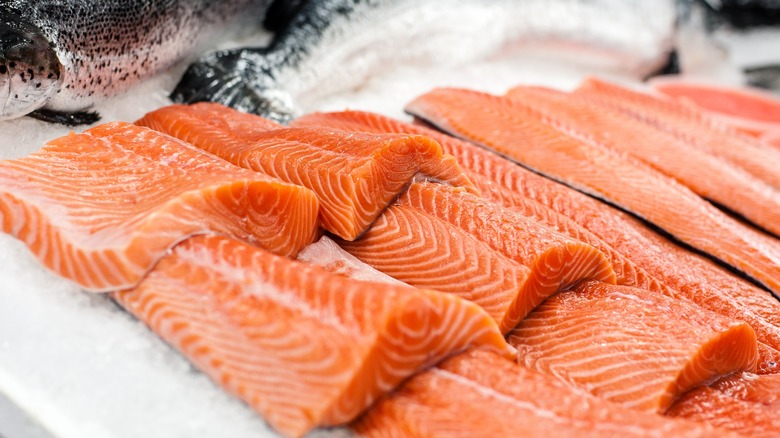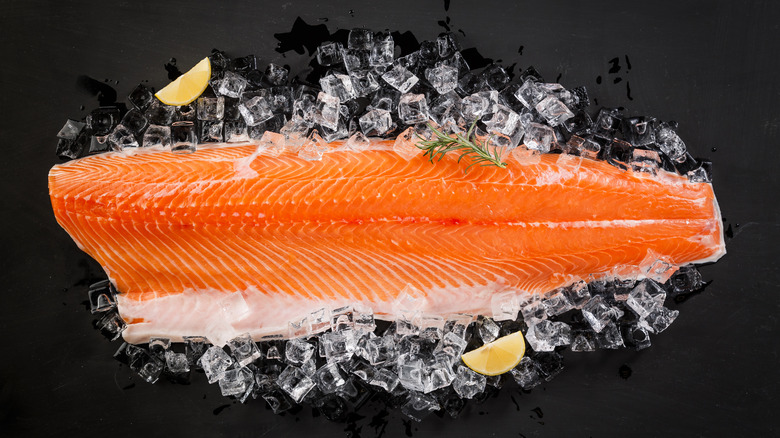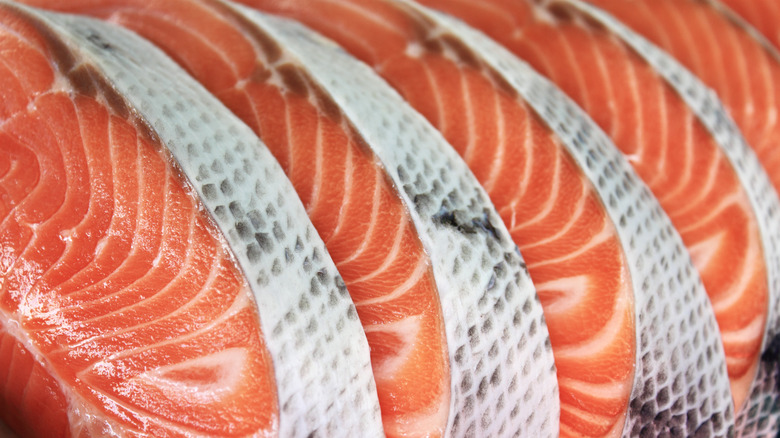What Is The Most Nutritious Type Of Salmon To Buy?
With a delicate but sweet fishy taste, salmon is favored by seafood lovers across the world. The fish is praised for its nutritious qualities as it is a solid source of omega-3 fatty acids and vitamins. However, there are two different kinds of salmon, with the fish either caught in the wild or farm-raised. They may seem similar at a glance, but if you're looking for a more nutritious option, then you should go with wild-caught salmon.
Wild salmon is more nutritious than its farm-raised counterpart. However, its limited availability makes it more expensive. Both types of fish contain omega-3 acids, but farm-raised salmon, due to their diets, contain a higher concentration of unhealthy saturated fats compared to their wild brethren — and you should limit the amount of fats in your diet due to general health concerns. Additionally, farmed salmon also lacks the same nutrients and minerals found in wild salmon. Again, this is all due to the dietary differences between wild salmon and farm-raised salmon.
In the restaurant industry, there's a bit of a negative stigma surrounding farm-raised salmon due to these discrepancies in nutrients as well as overall health concerns. However, farm-raised salmon are typically easier to come by than wild-caught salmon due to supply.
Wild-caught salmon is harder to come by
Compared to farm-raised salmon, wild-caught salmon make up a smaller percentage of the seafood market. Both Atlantic salmon and Pacific salmon are consumed in the United States. However, Atlantic salmon sold today is farm-raised due to the dwindling number of Atlantic salmon in the wild, leading the species to become endangered. Of the Pacific salmon, there are several types on the market: cutthroat, chum, chinook, pink, sockeye, coho, and steelhead, with the wild chinook being prized the most for its size and fat content.
However, farm-raised salmon makes up ¾ of the salmon served in the United States, according to CBS. Even salmon that is labeled as wild-caught is sometimes misrepresented as such, with the fish actually being farm-raised Atlantic salmon. Oceana discovered that this was the case in 43% of the salmon it tested from restaurants and stores across several states. While the industry is making advancements to improve upon its farming techniques, farmed salmon is generally inferior nutrition-wise to its wild-caught brethren.
Additionally, some consumers have concerns about potential contaminants making their way into the fish. According to a study available through the National Library of Medicine, trace metals and other pollutants are unlikely to negatively affect the quality of your salmon.
How to tell if salmon is wild-caught
If you've ever wondered if that salmon at Olive Garden is wild-caught or not, then wonder no longer. Generally, the color of the fish is a dead giveaway. Farmed salmon generally has a pink color that looks almost artificial — and that's because it is. Naturally, farm-raised salmon are a whitish gray, which isn't the most appealing to those expecting their salmon to have a bit of color. To give farm-raised salmon its hue, farmers will introduce additives to the salmons' feed. These supplements are called carotenoids and are taken from either algae or crushed crustaceans. By giving the fish the feed, it changes the color of their meat over time to the pink that everyone knows.
Comparatively, wild-caught salmon will be reddish-orange instead of pink and will be a darker shade than the lighter farm-raised salmon. By comparing the hues of the fish, you should be able to tell right away which one is farm-raised and which is wild-caught. However, if the color doesn't offer a solid enough guidepost, then the taste certainly will. Generally, farm-raised salmon has a lighter and more neutral taste. In comparison, wild-caught salmon are more pungent and have a sweeter, fishy flavor.


